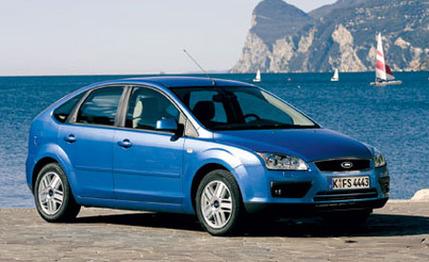
 Mini Test Road Test
Mini Test Road Test
There's a new Ford Focus for 2005. Oh, but you already knew that-we, in fact, tested a ZX4 ST in the July '04 issue. Well, that's the model that will be sold in the U.S. (It's the original car with a few cosmetic and specification adjustments.) On the other hand, Europe gets a truly new Focus that we won't see here.
There are two reasons why we aren't getting the all-new Focus, and they both have to do with money. First, the new European Focus has grown and moved upmarket. The larger platform it is built on, dubbed C1, is shared with the Mazda 3 and Volvo S40 and V50. Aside from the boost in size, the Euro Focus has more technical features and a better-quality interior. The jump in class would force the Focus out of its economy caste in this market. Second, the original Focus made its U.S. debut two years after it had been in European showrooms; thus, the current American Focus has completed only a portion of its life cycle.
Ford engineers admit that the first-generation Focus is a difficult act to follow. Its dynamics have been praised on both sides of the Atlantic-the Focus is a five-time 10Best winner-and even in its final months of existence, it is among the bestselling cars in Europe, as it has been since its launch.
The formula for the second Focus calls for improving the dynamic traits the enthusiast press has praised while increasing its size and honing the exterior design. The new car's footprint has been stretched out by an inch in the wheelbase and 1.6 inches in track. Overall length grows by an inch or so across the line, and the windshield has been moved forward four inches. The changes contrive to make the new Focus look lower and sleeker, even though it's a touch taller, and the bulging fenders emphasize its new, wider stance. Put an old Focus next to the new car, and the original seems narrow, angular, and dated compared with the gentle curves of the new generation.
The first Focus had radical styling, but the new car, although handsome, is conservative. In a European market that is increasingly attracted to something different-like the bustle-back Renault Megáne II-Ford may be playing it too safe.
For the chassis engineers, the challenges were to preserve the driving quality of the original, improve the ride, give the steering a more reassuring feel at high speed, and decrease road and wind noise. To quiet the car, they had the advantage of starting with the stiffer C1 structure, and to this they've added pricier and thicker glass.
To upgrade the ride and handling, shock-absorber volume was increased, and more-precise ball joints replaced the old flexible anti-roll-bar links. With an eye toward enhancing steering feel at autobahn speeds, there's variable-assist electrohydraulic power steering that dials in more effort, less assist, as speed increases. As a safety measure, the bigger brakes from the previous Focus ST170 (SVT Focus on our shores) were adopted across the range. The larger brakes should be up to the task of stopping the new car, which is about 115 pounds heavier.
Back-to-back tests of the new and old, on the extensive "global roads" course at Ford's Lommel proving ground in England, showed off the effectiveness of the engineers' handiwork. The new Focus was more stable, comfortable, and quiet than its predecessor as well as its competition from Opel and Volkswagen. The changing character of the variable power steering is noticeable, but it remains as precise through the turns as the original.
Europeans face six power options. One choice not on the books is our favorite Focus engine, the Mazda-designed 2.3-liter, but there are four gas burners based on that four-cylinder: a 1.4-liter, two 1.6-liter mills, and a 2.0-liter. Power for these engines ranges from 79 hp to 143. The new Mazda-based gas engines are a major step forward in power and refinement. For diesel fans there are two Peugeot-sourced turbo-diesels, a 1.6-liter making 109 hp and a 134-hp, 2.0-liter unit.
Although most of Ford's competitors offer six-speed manuals across the range, only the diesel engines are available with six self-shifted cogs. The other choices are a five-speed manual, a four-speed automatic, or a CVT.
High-performance versions of the new Focus are promised for a later date. The first of these, labeled ST, is expected to pack a 200-horsepower Volvo five-cylinder engine. Which reminds us: Ford's C1-platform technologies extend through its empire. If you want to experience the latest Focus, you can do so-albeit with different chassis tuning-in a Mazda 3 or Volvo S40 or V50.